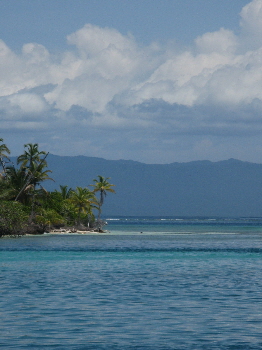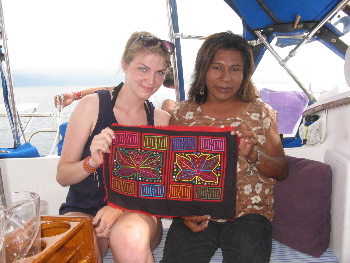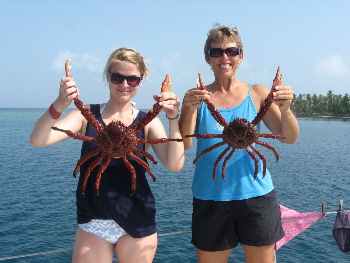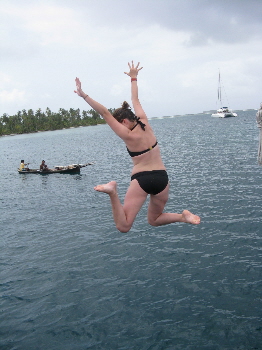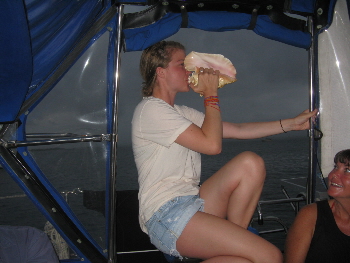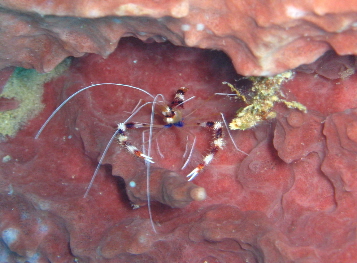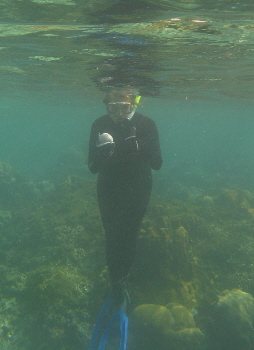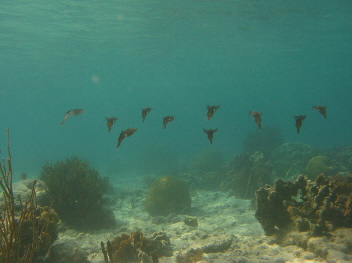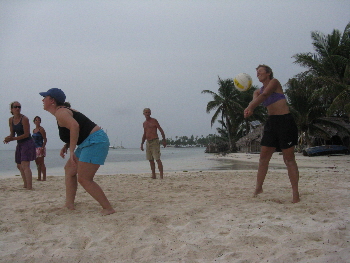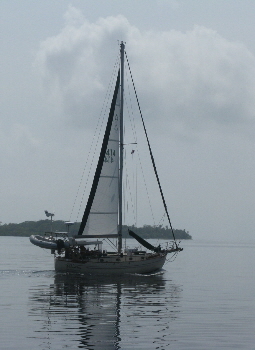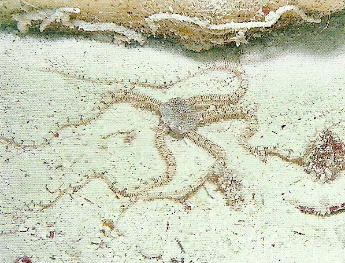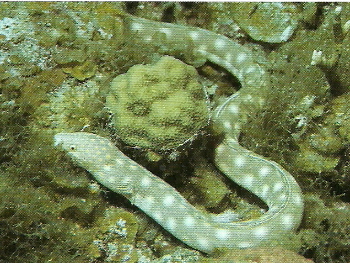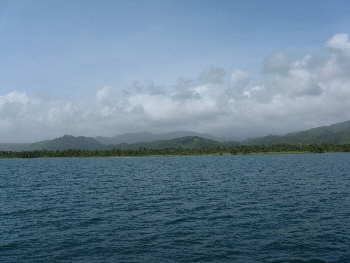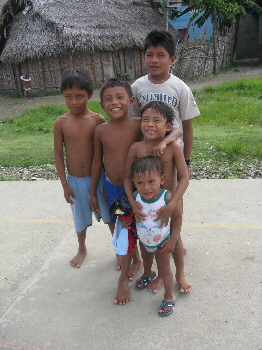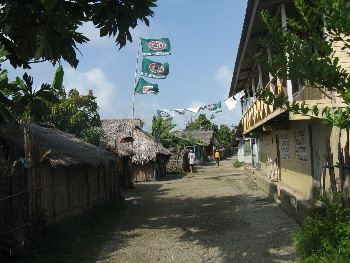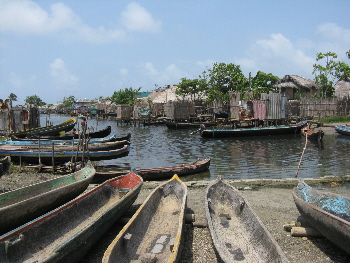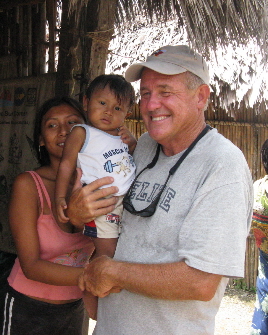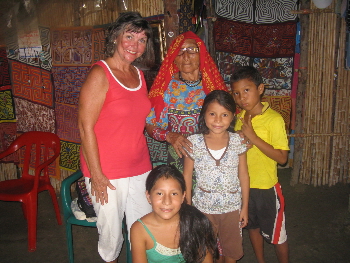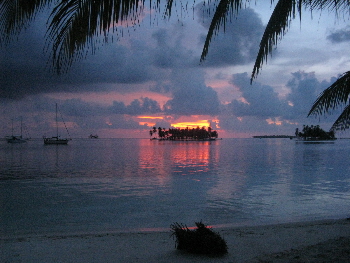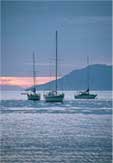
Current Location
(enter callsign KG6NNZ)
Logbook: Colombian Islands & Panama - May to August 2009
Below is the log of our travels with both photos and text. If you prefer to just view the photos, you can click here for a slide show, which includes all of the photos below, as well as a few others.
| When we left Honduras' Vivorillos Cays in late May, we
were headed south. June 1 is the official start of the Caribbean hurricane
season, and although there were no tropical disturbances on the horizon, we were
eager to get down to the lower latitudes where hurricanes don't go.
Specifically, at the direction of our insurance company, we needed to be south
of latitude 13. The Vivorillos sit just south of latitude 16, so we
had close to 180 miles to go, which could take a couple of days on Slip Away. From the Vivorillos, we headed toward Panama, stopping at a couple of the Colombian Islands off the coast of Nicaragua on the way. When we reached Panama, we spent several days enjoying the tranquility of the Rio Chagres before heading to the San Blas Islands (aka Kuna Yala), where we spent seven weeks immersed in the Kuna Indian Culture, snorkeling in beautiful warm blue waters and feasting on seafood. Although we were out of the hurricane zone, we were into the rainy season, and we experienced a fair amount of squally weather. It seems that every place has a local name for these storms - they're called "chocasanas" in Panama. We had a couple of close calls with disaster in Panama - a scary encounter with a freighter in Colon and a grounding during a chocasana in the San Blas. Although they were experiences we'd rather forget, we learned good lessons from the mistakes we made, so hopefully we can avoid situations like those in the future. |
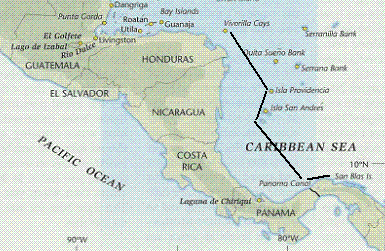 |
Passage from Cayos Vivorillos to Low Cay, Colombia (May 26-27, 186 nm, 31 hours). During the few days we spent in the Hobbies and Vivorillos Cays, we enjoyed extremely calm weather. The period of tranquility was about to end, however, as the tradewinds were forecast to re-establish, so it was time to move on. We left the Vivorillos Cays early in the morning and motored into light southeasterly winds. We weren't really sure where our next stop would be - we planned to see how the trip went and stop where it was convenient. A couple hours after getting underway, we were hit by a squall with about 30 knots of winds and blinding rain. Fortunately, we were no hazards close by and our autopilot steered our course. That was the only squall we experienced during these couple of days underway, but for the remainder of the trip, we had 12-15 knots of wind from the southeast and then east, which put it about 30 degrees off our bow - too close for Slip Away to sail, and we motored. The seas were lumpy and uncomfortable, and occasionally one would break over the bow and soak the boat. Rich's entry in our logbook a couple of hours before dropping our anchor at Low Cay said "wet, nasty ride."
Low Cay, Colombia (May 27). Low Cay sits off the north end of Isla Providencia, and we'd heard good things about this anchorage from other cruisers, so we decided to stop, get some rest and maybe spend a day or two. With the moderate easterly winds, however, the anchorage was rolly and uncomfortable. We spent a total of 2½ hours in the anchorage - we cooked dinner, took a shower and then decided to continue on to Albuquerque Cays.
| Passage from Low Cay to Albuquerque Cays, Colombia (May
27-28, 91 nm, 19½ hours). Although the wind and sea conditions
had not changed, the direction to Albuquerque Cays (which sit just south of
San Andres) was south-southwest, which was an ideal point of sail in these
east winds. With 10-15 knots of wind now on our beam, we had a
lovely sail under jib and jigger (headsail and mizzen), and Rich's 0500 entry in
the logbook said "NICE SAIL" - much better! At 0930 the next
morning, we had a pod of bottlenose dolphins playing in our bow wake,
including a couple of babies with their moms. We are always enchanted
by these creatures, and we stood on the bow and watched them glide
effortlessly through the water.
Albuquerque Cays are two small islands, between which we would anchor, but the islands are surrounded by reefs, and safely entering the anchorage involved following a series of waypoints provided to us by other cruisers. Arriving in good light is imperative - with the sun directly overhead or behind - so that one can see the reefs and judge the depth by the color of the water. Our timing was good as we arrived close to noon, and we easily found our way in and dropped our anchor. |
|
Albuquerque Cays (May 28-30). When we arrived at Albuquerque Cays, our location was 12 º 09', so we were now below 13 degrees of latitude and out of the hurricane zone - and we made it a few days early! We joined three boats already here at anchor - Tempest, Pelican's Flight and Jacana. We didn't know the folks on these boats well, but we'd previously met Bob & Annette on Tempest and knew the other two from the radio. They welcomed us like old friends, and we enjoyed getting to know them better over a few drinks on Slip Away. Tempest also helped us out by selling us a couple of jerry cans of diesel. Although we figured we had enough fuel to motor all the way to our next destination, that extra ten gallons gave us a little extra cushion. The water in these cays was a beautiful aquamarine blue and very clear. The snorkeling was excellent, and we found several large conch - the biggest we've ever seen. A couple of the conch made it on to our dinner plates and were delicious! We wished we could have stayed here a little longer, but after a couple of days, all four of us moved on because some rough weather was headed our way. The other three boats headed to Bocas del Toro, Panama, and we headed toward Colon.
Passage from Cayos Albuquerques, Colombia, to Colon, Panama (5/30-31, 220 nm, 36 hours). We left the Albuquerque Cays with light easterly winds and 1-2 foot seas, and since we were headed mostly south, we were having a nice sail. We sailed for the first eight hours of this passage, but then the wind veered south and died out, so we motored. That night we dodged squalls and watched the lightning, praying that it would not hit us. We sailed for a couple hours the next morning, but then the squalls started again, and the wind veered south, so the engine came back on. We were not able to dodge all the squalls that day and were hit by a couple with 30+ knots of wind, blinding rain, and lots of lightning, but we came through with no problems.
Although Panama doesn't get hurricanes during the summer, it does get a lot of lightning, and our biggest fear was a lightning strike. Lightning strikes usually fry boat electronics and navigation equipment. As a safety measure, we stored a laptop computer with navigation software and USB GPS receiver in our oven, as well as a handheld GPS and VHF radio in our microwave. The oven and/or microwave will usually protect anything stored inside from a strike.
We tried to time our arrival at Colon during daylight, but we arrived sooner than anticipated, late in the evening on the second day. We don't normally enter an unfamiliar anchorage in the dark, but this harbor entrance is well marked since Colon sits on the Caribbean side of the Panama Canal. Also, we'd been in the Flats anchorage a couple of years ago, and there were no major hazards to navigation - at least not in terms of reefs and/or shallow waters. The weather was clear when we arrived, so we felt comfortable going into the harbor and anchoring in the dark. What we didn't anticipate was the number of big ships anchored both outside and inside the harbor breakwall, which showed up as an incredible number of hits on our radar screen. We found a clear path to the entrance buoy and proceeded inside the breakwall, staying along side the shipping channel. When we got inside the breakwall, there were still numerous hits on the radar - ships anchored inside - and Rich went out on the bow with a spotlight to help Jan, who was steering through the obstacle course. There was a big ship ahead of us, and we turned to starboard to go around it, but what we didn't realize was that this ship was moving and we were in its path! Fortunately, with Rich on the bow, he noticed the bow wake of the ship, and he told Jan to hit the throttle and get out of the way. The big ship missed us by probably 100 yards, which was way too close for our comfort. We're pretty sure that ship never saw us. Our hearts were pounding as we navigated our way to the anchorage. In hindsight, we should have noticed that this ship was in the shipping lanes, but with all those hits on the radar screen, it was hard to process all the information. Also, we were tired after a long and arduous passage, so our minds weren't as sharp as they could have been. We were relieved to drop our hook in the Flats anchorage, but then we had one more issue to deal with. As Jan backed down on the anchor, she heard an awful sound come from the direction of the engine room. Rich went down below to find that the shaft coupler had come apart. Fortunately, the problem was fixable, but it had to be taken care of immediately because we were disabled in this condition. Since the engine had been running for several hours, it was a hot and sweaty job, but Rich re-assembled the pieces in relatively short order. We were dog tired when our heads hit the pillows that night.
Colon to Rio Chagres, Panama (6/1, 2½ hours, 16½ nm). We slept in the next morning, waking up just in time to catch the Panama Pacific Net on our SSB radio. The Net Controller for that day was a friend we knew from cruising on the Pacific Coast, and we checked in to say hello to her and several other old friends - what fun! The anchorage in Colon isn't a great place to hang out, so we were headed to the Rio Chagres that day. We didn't have far to go, but first we needed to buy some fuel. Just before noon, we weighed anchor and headed to Shelter Bay Marina to fuel up. Their fuel dock situation isn't very well organized. We had to dock Slip Away near the office, go in the office and give them our credit card, then move Slip Away to the fuel dock to fill up, then move back to the dock near the office to finalize the bill. It wouldn't have been a big deal, except that when we got to the fuel dock, there was a problem with the pump. We waited two hours at the fuel dock for the pump repair - we were beginning to think we might spend the night there! They finally got it working, and we filled up, re-docked at the office, paid our bill and got underway at 3:30 p.m. The entrance to the Rio Chagres was just six miles away (about an hour for us), so we had enough time to get into the river and anchored before dark.
Rio Chagres, Panama (June 1-7). The Chagres River was dammed in 1910 to create Gatun Lake, which is part of the Panama Canal, and it also supplies the water for the locks of the Panama Canal. The river sits in the heart of San Lorenzo National Park, a nature preserve and area of virgin rainforest. We've done some jungle river cruises in our dinghy, but this was the first time we've ever taken Slip Away on one. It was incredible! As we motored up the river, the howler monkeys howled and welcomed us. When we anchored and shut down the engine, Jan went below to shut off the exhaust fan, but she could still hear a buzzing noise. She came up into the cockpit to figure out what it was and realized it was the jungle noises. The anchorage was very calm but never quiet with all the sounds of birds, monkeys and bugs.
We saw lots of activity just sitting in Slip Away's cockpit, and we also explored in the dinghy so we could get a closer look at the wildlife. We watched howler and white-faced monkeys playing in the trees, white egrets wading along the shore, flocks of blue and green parrots squawking loudly as they flew by us, and toucans singing from their tree-top perches. We were pleasantly surprised that the mosquitoes and no-seeums were not bad, so we didn't have to keep the cockpit screens in, and we had a unobscured view of what was going on outside. This was a very special place! We didn't swim in the river because there are some resident crocodiles, although we never saw any.
|
|
|
|
|
|
|
|
We found only one other cruising boat in the Rio Chagres - Allways Sunday, with Ricky, Robin and their sixteen-year old daughter Danielle on board. We tried hiking to some waterfalls with them, but it was raining and we didn't really know where we were going, so it ended up being a short excursion. We also enjoyed some nice meals with Allways Sunday and spent an evening playing some games. This family had just bought their boat and were on their maiden voyage, and we hoped their first impression of the cruising community was a good one!
After hanging out in the Rio Chagres for four days, we decided to move further down the coast to Portobelo. As we approached the exit of the river, the sky was black and ominous, and we turned around and came back up the river. We had no desire to go out there and get our butts kicked! Our weather forecaster told us the squally weather would ease up in a couple more days, so we hung out in the river a little bit longer.
| Portobelo, Panama (June 7-10). The weather finally improved, and we made our way to Portobelo. Winds were calm, so it was a motor trip (30 nm, 4 hours). When we arrived in Portobelo, we found an internet cafe to download our non-radio email and got the lay of the land. It had been almost a month since we were last in a good grocery store and laundromat, so we were in search of those services. We were familiar with taking the bus to Sabanitas (about an hour away) to get to a Rey's, which is a well-stocked grocery store, but we were hoping we'd find some laundry facilities in Portobelo. Unfortunately, the washers were all broken in the only local laundromat, and since the weather had been so rainy, we weren't keen on the idea of paying one of the locals to wash our laundry and hang out in their back yard to dry. That could take days! So, the next day, we took the bus to Sabanitas, scouted out a laundromat there, bought some groceries at Rey's, and took the bus back again. The day after, we again took the bus to Sabanitas, laundry in tow. We spent several hours doing our laundry in a small shop with two washers and one dryer (all normal household-sized machines), but it was cheap and the clothes were clean and dry when we were finished. We then went back to the grocery store, stocked up on fresh fruits and veggies and heavy stuff like bottles of rum and wine, and we splurged and spent $20 to have a cab drive us back to Portobelo. |
|
Isla Linton, Panama (June 10-11). After two days of bus rides, grocery shopping and laundry, we didn't feel like doing a long passage. But, we also didn't really feel like staying in Portobelo any longer. We spent a day in Portobelo a couple of years ago and thought it was OK, but this time it seemed seedier and felt a bit unsafe. So, we decided to move a bit further down the coast to Isla Linton (10½ nm, 1½ hours), another anchorage we had visited a couple years ago and liked. It was a rainy and squally day as we motored down the coast, and we could hardly see the anchorage for the rain as we approached it. We still had our old waypoints and our chartplotter was accurate, but we were happy when the rain finally abated so we could get into the anchorage with no trouble.
Passage from Isla Linton to the San Blas Islands (June 11, 49 nm, 7 hours). We left Isla Linton early the following morning and headed to the San Blas Islands. We had no squalls on this passage, which was a welcome change of pace. We also had no wind, so we had to motor the entire distance. We planned to land at El Porvenir, where we could do our check-in with officials, but as we approached that anchorage, Tim & Paula on Hooligan were departing it, and they advised us by radio that the Immigration Officer was out of town for a few days, so we might as well wait until he returned to do our check-in. We didn't really have an alternate anchorage planned, so we asked Hooligan where they were headed and if we could tag along. They were headed to the East Lemmons, just about 5 miles away, and were happy to have us join them. (We'd never met Tim & Paula before, but we'd talked to them on the radio and knew they were from Southern California, so we were looking forward to meeting them.)
San Blas Islands / Kuna Yala
Two years ago, after transiting the Panama Canal from the Pacific, we spent ten days in the San Blas Islands, and we knew we wanted to return. The San Blas Islands (also referred to as Kuna Yala), are an archipelago of over 350 islands along Panama's Caribbean coast. Most of the islands look like postcards with coconut palms poking out of white sand and surrounded by aquamarine waters.
|
|
|
The San Blas Islands are officially part of Panama, but they are ruled autonomously by the Kuna Indians. The islands are reachable by airstrips built by North Americans during World War II, but there isn't much in the way of accommodations here, so the best way to visit these islands is on a boat. Since it was summertime and it was fairly easy to get to the San Blas, many of the cruising boats had visitors - kids, grandkids, other family members and friends. In July, we too had a guest. Our niece Tyler traveled from Maryland to spend a week with us on Slip Away.
| The islands have a reputation for
warm clear
blue water and beautiful coral reefs. There were lots of reefs in the
area, so one needed to pay close attention when navigating. Marine charts
of the San Blas aren't all that good, so learning to read the water became a
very important skill. Summer weather differs greatly from winter weather
here. In winter, the climate is dry with steady winds from the northeast,
but in the summer rainy season, winds can come from any direction, sometimes
light and sometimes strong, which makes anchoring a bit trickier. One
thing we learned very quickly is that whenever we moved between anchorages, the
winds were either completely calm or blowing from the direction we wanted to go,
so our engine got a fair amount of use.
On this visit to Kuna Yala, we were planning to stay close to two months. We spent most of that time cruising among the island groups in the Western San Blas - the Lemmons, the Holandes, Green Island, Esnasdup and a couple others - as well as visiting Carti and Nargana, two of the main villages in this area. Everything was very close - it was unusual for us to travel more than ten miles in a day. At the end of our stay, in early August, we sailed through and made a few stops in the more remote Eastern San Blas on our way to Colombia. |
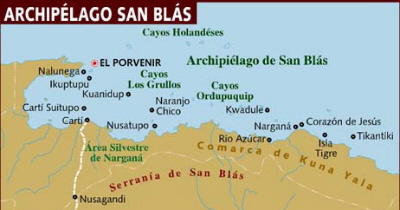 |
Cruising in the San Blas was an interesting study in contrasts. There was no internet, but there was cell phone service, and almost all cruisers and many of the Kunas had cell phones. (Calls to the US on our Panama cell phone were cheap - about $1.20 for 20 minutes.) Most of the Kunas had no electricity in their homes, so they would ask cruisers to charge their phones on our boats. There was only one washing machine, which was in Nargana, a non-traditional village that had a generator for electricity. Most cruisers did their laundry by hand in a bucket and hung it out on the boat to dry - it was good that our attire was primarily bathing suits and shorts. The food tiendas in the villages had only basic items for sale, and if you hit town on the wrong day, they could be out of fruits, veggies and eggs. However, a few enterprising locals figured out that if they loaded up their lanchas (motorboats) with fruits, veggies, eggs, and even sometimes frozen chickens, beer, rum, gasoline and diesel, they could make money selling these items to the cruisers. Of course, there was no scheduled time or location for when these "veggie boats" would show up, but when one did, the radio came to life announcing the arrival. A whole chicken was a little expensive - maybe $6 - but one could buy a large crab for $3 and most lobsters for $2. Some boats spend months on end in the San Blas Islands, and when they get low on provisions, they go shopping in Panama City - worlds away culturally from the San Blas but only three hours by jeep ($50 roundtrip) or less than an hour by plane ($100 round trip). Kuna women make and sell "molas" which are fabric panels with colorful designs appliquéd on them; however a couple of the more famous mola makers are transvestites. (In the Kuna culture, if the youngest child is not a girl, they dress him up like one.) While some Kunas were involved in commerce with the cruisers, many of the others led a traditional life of fishing from their "ulus" (dugout canoes powered by either sail or paddle and sometimes both), tending crops on the mainland and collecting coconuts for trade with the Colombians. Most of the Kunas lived in villages, but there were some families assigned by the chief (called a "Sahila") to live on the more remote islands.
|
|
|
|
|
|
|
|
As a guess, we think there were probably about 50 boats cruising the San Blas Islands while we were there. Although there are over 350 islands in the San Blas, one could find most cruisers gathered in a handful of anchorages. There are a variety of reasons for this - some of these anchorages had some of the best snorkeling or offered the best protection in case of a storm, and some cruisers just like to have other folks around. We visited and liked some of these "popular" anchorages, but also found a few good ones that we enjoyed by ourselves or with just a couple other boats around.
East Lemmons (June 11-16). We followed Hooligan to the East Lemmons, and found a spot to anchor near the island of Banedup. We spent the next few days here meeting new friends and reconnecting with a couple of old ones, including Neil & Kathy on Attitude, who had their grandson Jarrid visiting with them. (It's such a small world - Neil was Jan's boss at P&G 25 years ago!) "Mr. G" lives on Banedup. He's a Kuna Indian, who was converted by the Mormons and lived in Salt Lake City for a while, so he speaks English fairly well. He hosts a weekly cruiser dinner - usually lobster or fish with rice, salad and a beer for $5/person. We attended one while we were here, along with about 20-25 other folks. After the dinner, Neil & Kathy from Attitude and the two of us played volleyball with the some of the kids, which was really a lot of fun. Mr. G also bakes bread on the island. Kuna bread is very popular among cruisers, and it's pretty darn good when it's warm from the oven.
|
|
|
El Porvenir, Carti & West Lemmons (June 16-19). Tim & Paula from Hooligan joined us on Slip Away for the trip to El Porvenir to check-in with the officials. We needed to do our initial check in, and they needed to renew their tourist visa. The Port Captain and Immigration Officers were both in their offices that day, and we got through the paperwork without too much hassle. We usually dress up a bit when we deal with officials because most of them wear some kind of uniform. However, here in Kuna Yala, the Port Captain wore ripped shorts, a well worn t-shirt and had bare feet. After the official business, we had lunch at the one restaurant on El Porvenir (lots of fried food), did some browsing through the two or three local food tiendas (not much that looked appealing), and we tried to buy a cell phone, but had no luck. We went back to the East Lemmons for the night and the next day headed to the village of Carti in search of a cell phone. Again, we had no luck finding one, but we did meet "Eulogio" who organizes the jeep trips to Panama City, and he said he could have his driver pick up a phone for us in Panama City. We agreed on a price, and he told us to come back early the next morning. Rather than spend the night at Carti, we headed to the West Lemmons (just 7 nm away), so we could spend the afternoon snorkeling. Early the next morning, we returned to Carti, but the cell phone hadn't arrived yet - heavy rains the night before caused a river to overflow its banks, so the jeeps couldn't come back that day. Eulogio told us the phone would be there the next day. Rather than motor back and forth from the West Lemmons, we decided to spend the night at Carti. The phone eventually made it to us in Carti via Sonny & Kay on Valentina, who arrived from Panama City via jeep the next afternoon. That evening, we had dinner with Sonny & Kay, as well as Marc & Patti on Alpha Wave, at one of the two restaurants in Carti. The company was fun, but the food was, well, fried ... fried chicken, fried plantains and french fries.
|
|
|
|
Western Holandes (June 19-23). When we left Carti after finally getting our cell phone, we headed to the Western Holandes. We'd heard the snorkeling and fishing was good there and the water was some of the clearest in the San Blas. Also, this was not one of the busy anchorages, so we were looking forward to a little time with just the two of us.
The previous days' heavy rains carried a lot of debris into the ocean from the overflowed rivers on the mainland. The Holandes islands are almost ten miles offshore, but the debris and murky water still came out that far. When we snorkeled, the visibility was lousy and we were swimming among palm branches, logs and plastic garbage floating in the water. Rich was reading Jan's mind when he said "This is grossing me out!" and we quit. At this point, we were feeling a little disappointed and were starting to question our decision to come here in the rainy season. This wasn't the superb snorkeling we expected to find here.
We did have a really nice encounter with a local Kuna family in this anchorage. We were getting used to visits from the locals - they knocked on the hull of the boat selling lobster or crab or molas, or they would ask us to charge their cell phones, or sometimes they would just ask for a Coke or candy. The asking for a Coke or candy got a little bothersome because it happened quite often. Coke and candy were neither cheap nor easy to get in Kuna Yala, and the Kunas weren't offering anything in trade. While here, a young family came out in their ulu and asked us for some cooking oil. Jan was a little irritated, wondering what they were going to ask for next, but she went down into the galley, found an empty container, poured some oil into it, and gave it to the young Kuna mother. Jan was really taken by surprise when the young woman then offered Jan a small mola. At first, Jan started to decline the gift, mostly because she felt the Kuna woman was offering her something more valuable than the small amount of oil she had given her. However, Jan didn't want to insult her and also didn't want to encourage her to expect hand-outs from cruisers. So, she graciously accepted the small gift from the Kuna woman, and then asked her to wait while she went down below and found a pair of hot pink Crocs that she was wanting to give away. The Kuna woman's eyes lit up when Jan asked her if she would like the shoes. This young family lived by themselves on the nearby island and told us we were welcome to visit their island whenever we wanted.
| East Lemmons (June 23-26). We left the Western Holandes intending to head to the Eastern Holandes, but changed direction mid-stream, so to speak, and headed back to the East Lemmons when we heard that Valentina was headed there. Although we didn't know Sonny & Kay well, our impression from the short time that we'd spent with them was that they would be fun to hang out with (and we were right!). Also, Sonny & Kay had spent a fair amount of time in the San Blas, and it's always nice to find folks who know the area well. We hung out in the East Lemmons for the next couple of days; the rains diminished, the water started to clear up, we found a couple of good snorkel spots, and life was good again. We also went out fishing one day - we took Sonny & Kay on board Slip Away and spent seven hours driving back and forth over a seamount. Valentina had fished there before and caught a bunch of good fish. Our first few hours out, all we got were a few hard hits, but all of them threw the hook early in the game and we never landed anything. We were about to give up and head home empty handed when our luck finally turned. In the end, Sonny landed a big barracuda and Rich landed three Sierra Mackerels - all good eating. We were happy to be putting some fish in our freezer. |
|
Esnasdup & Green Island (June 26-July 2). When we left the East Lemmons, we followed Valentina to one of their favorite anchorages at the island of Esnasdup. It was a lovely anchorage with good snorkeling close by, but the bugs were ferocious that night, so the next morning we moved just a couple miles away to Green Island. The bugs weren't bad at Green Island, we found more good snorkeling, and we ended up spending almost a week here. Green Island was one of our favorite spots. The anchorage usually only had a few boats in it, there were lots of spots to snorkel, and we saw some great stuff, including a couple of octopus, a nurse shark, a juvenile spotted drum and probably the tiniest juvenile angelfish (grey or French, we couldn't tell) we've ever seen. We also had a couple of other very unusual sightings - a juvenile high hat, a red-lip blenny and a Caribbean Spanish Dancer, that Jan found "dancing" about three feet away from the reef - very cool!
|
|
|
|
The town of Nargana is just a couple of miles from the Green Island anchorage, and Jan took the opportunity to visit it with Valentina and Alpha Wave, riding along in Sonny & Kay's dinghy. Nargana is considered to be the most modern of all the Kuna villages - they have a generator for power and several of the buildings are made of concrete - but it's a far cry from modern as we know it. One can find some basic provisions here, and we were lucky enough to go on a day when a supply boat arrived, so we picked up a good load of fresh fruits and veggies. We had lunch at Nali's cafe - fried chicken, but Jan was able to get it with rice and lentils instead of fried side dishes - and ice cream for dessert. It had been quite a while since we last had ice cream - and Rich missed out! The kids were incredibly friendly in Nargana - most of them asking us to take their picture, and then asking to see it on the back of the camera, which would send them into fits of giggles. After lunch, we sent some of the local teenage boys on a mission. Both Valentina and Slip Away have pet geckos on board, and Alpha Wave wanted some too, so we asked a few of the local boys if they could capture a few "lagartitos" (small lizards). The boys were thrilled with their assignment and would have brought us a dozen if we hadn't stopped them. Marc & Patti went home with three geckos, and the boys went home with a couple of bucks in their pockets.
|
|
|
|
The Swimming Pool, Eastern Holandes (July 2-10). One of the most popular anchorages in the San Blas is called the "Swimming Pool" and is located in the Eastern Holandes group of islands. It's popular for a variety of reasons - the anchorage is large and well protected, the water is clear and there are lots of good reefs for snorkeling. It also tends to be the center of the social scene in the San Blas. One couple, Reg & Deb on Runner, have pretty much made this anchorage their home for the past several years. Reg took on the responsibility as caretaker of "Barbeque Island", clearing the island of dead palm branches and keeping the beach clean, and cruiser potlucks are held on the island once a week. They were planning a big 4th of July party in the Swimming Pool, and our friends on Attitude were there, so we decided to check it out.
We arrived in the Swimming Pool on July 2nd and found a great place to anchor in the middle of three beautiful reefs we could easily swim to from Slip Away. The next morning, at about 5 a.m., we were shaken awake by an earthquake. Although we'd never felt one on the boat before, we were familiar with earthquakes from living in California, so even in our groggy state, we knew what it was. Later that morning on the radio net, it was reported that there had been a magnitude 6.5 earthquake centered just off Porvenir, about 18 miles from us. That's no small earthquake - no wonder it woke us up! Fortunately, the Kuna villages suffered no damage. July 3rd was also our 10th wedding anniversary - wow, 10 years!
We celebrated the 4th of July, with a diverse group of nationalities - Americans, Canadians, Europeans and a few others. Cruisers are always happy to help celebrate other nations' holidays. The "pool party" included some interesting red, white and blue outfits, a delicious spread of food and a conch blowing contest.
|
|
|
We hung out in the "pool" for several more days, mostly enjoying the snorkeling. In addition to the reefs near Slip Away, there were many more to explore. Deb on Runner had a hand-drawn map of the different reefs in the area, and we checked out some of those by dinghy. A couple of the highlights of snorkeling here included numerous tiger tail sea cucumbers that would come out to feed in the afternoons on "Barracuda Reef" and several sightings of both blue and green lettuce leaf sea slugs.
|
|
|
|
One morning, Attitude took us to their favorite spearfishing location along the inside of the outer reef. Rich speared an ocean trigger and Jan got a lobster, but Neil was the big winner with five fish, including a barracuda, the first he'd ever shot.
|
|
|
|
After a week in the "pool", we moved on. We'd been in touch by radio with Valentina, and Sonny had asked Rich if he would like to go to Panama City with him by jeep to help him pick up some new boat batteries. Rich was up for the adventure, so we planned to meet Valentina in Carti, where they would catch a jeep to the big city. We had a couple of days before we needed to meet them, so we decided to check out some other anchorages that were off the beaten path.
| Cambombia, Esnasdup, Nubesidup, West Lemmons (July 10-12). Another cruiser told us of some great snorkeling near the island of Nubesidup. The anchorage at Nubesidup wasn't protected enough for an overnight stay, but the island of Cambombia was close by, and that was supposedly better. The anchorage at Cambombia was open to the west, and of course that day the winds decided to blow from the west. We pulled into the anchorage and dropped the hook but quickly decided we were not comfortable here. Esnasdup, the beautiful but buggy anchorage we stopped at briefly a few weeks prior, was close by, and we thought maybe the bugs wouldn't be so bad with the wind blowing, and headed over there. We had the Esnasdup anchorage to ourselves, and we were right about the bugs - they weren't there - and we had a lovely evening. The next morning, some fisherman stopped by Slip Away selling lobster. While talking to them, they pointed to a crocodile swimming in the anchorage. Yikes! We remembered Valentina telling us not to swim in this anchorage because of the crocodile, but we didn't see him the last time we were here. We left shortly thereafter and headed to Nubesidup, where we anchored for a few hours, did some snorkeling and then continued on to meet Valentina in the West Lemmons, a nice protected anchorage, with no bugs and no crocodiles! That evening, as we sat having a beer and some popcorn on Slip Away and making plans for the boys' trip to Panama City, Sonny broke a tooth. Visiting the dentist was added to their "to-do" list in Panama City, and it became clear they would need to spend a night to get their errands done. |
|
Carti & West Lemmons (July 12-16). We snorkeled around the West Lemmons the next morning, and that afternoon, we headed into Carti. We didn't really like the anchorage at Carti, but we figured we could deal with it for a couple of nights. Sonny & Rich were supposed to leave on the jeep early the next morning, and Kay & Jan would stay on the boats while they were gone. That first night, the wind picked up a little out of the north, the anchorage was very rolly, and we got very little sleep. Additionally, we felt like our anchor didn't set well, and when the wind shifted, we were too close for comfort to another boat. We were having some problems with our anchor windlass, so Jan didn't feel confident trying to handle Slip Away on her own if the anchor started dragging. So, early in the morning, we weighed anchor and drove around trying to find a calmer spot with better holding. We finally found a spot where the anchor seemed to set, and we were a comfortable distance from everyone else. It was still rolly, but Jan thought she could deal with that for just one more night. Sonny & Rich were supposed to be picked up at 7 a.m. by a lancha which would take them to the jeep for Panama City. About 7:30, Sonny called the jeep driver, and he was told they were running an hour late. An hour turned into several hours, and finally the trip was cancelled until the next day.
Spending two more nights at the Carti anchorage wasn't appealing at all. We got in touch with another lancha driver (Alberto) who agreed to pick up Rich and Sonny at the West Lemmons the next morning and bring them into Carti. We were all much happier with this option and headed off to the West Lemmons, where the anchorage was calm, our anchors set well, and we had lots of swing room - even enough to put out some extra anchor chain in case of bad weather. We all got a good night's sleep and the next morning, Rich & Sonny left for Panama City. Jan & Kay were both content to have a day to themselves on their own boats. Neither of them bothered to launch their dinghies, but they did chat a few times on the radio, and Jan beat the heat of the day with an afternoon swim. Blue Sky, with Breeze & Debbie aboard, joined them in the anchorage that afternoon, and Breeze assumed the role of "father hen" checking in with Jan & Kay on the radio and assuring them that they could call on him if they needed anything.
| The girls enjoyed a lovely calm night on their own on
Slip Away and Valentina, but
that changed early the next morning. At about 7:30, they were hit with
a strong chocasana. Both ladies remained calm and rode out the storm,
keeping an eye on their relative positions to each other and the surrounding
islands, although at times it was raining so hard, it was hard to see anything.
Jan left her navigation instruments off because she was concerned about a
lightning strike, but Kay turned hers on and saw the wind gust up to 49 knots.
Kay said it was the strongest storm they had ever experienced in the San Blas.
With the exception of a torn awning on Valentina, the ladies made it through
the storm with no problem, and they were extremely grateful that they were in the West Lemmons
and not Carti. Sonny & Rich came back late that afternoon in a loaded down lancha. In addition to Sonny's batteries and the trip to the dentist, they took advantage of the opportunity to get a propane tank filled, buy some Sunbrella for a boat project on Slip Away, and pick up some provisions - canned goods, cereal, butter, wine, rum and a few other items that were difficult or impossible to get in the San Blas. That evening, Breeze & Debbie invited us over to Blue Sky for a potluck dinner and an evening of music. Breeze played guitar, and Sonny played the harmonica, and we all sang along to some Jimmy Buffett songs. We spent another day in the West Lemmons stowing all of our purchases, and enjoying a happy hour on the beach the next evening. |
|
East Coco Banderos (July 16-18). The East Coco Banderos is another anchorage that is popular among the cruising community, with a reputation for good snorkeling and spearfishing, as well as being one of the prettiest anchorages. We had a few days before our niece Tyler would be arriving for a visit, so we decided to spend them in the "East Coco B's." The anchorage here is really beautiful, and there were numerous reefs to snorkel on, but the anchorage itself was small and crowded, and boats were anchored much more closely to us than we prefer. One of the evenings here, we enjoyed a nice potluck dinner one evening with Hooligan, Attitude and Mystic Moon on one of the islands. We built a fire and grilled fresh fish (most of it caught by the crew of Attitude). Attitude had more family visiting - Neil's daughter Christine with her husband and small daughter. Jan remembered meeting Christine many years ago when she was a kid hanging out in her Dad's office.
Nargana (July 18-21). We left the East Coco Banderos and headed for Nargana so that we could meet our niece Tyler who was on her way to visit us. Nargana has an airport with daily flights on small planes to and from Panama City. Tyler is 16, was traveling on her own to Panama, and flight schedules were such that she would have to overnight in Panama City, so Jan flew to Panama City to meet her. Jan was flying out on the same day as Christine and her family, so we were all in Nargana together.
|
|
|
|
Panama City (July 20-21). Since a trip to Panama City is an opportunity to shop at real grocery stores, Jan flew in a day early to run errands. (It's amazing how much food we go through when we're eating three meals a day on the boat, and we also needed to stock up for our trip to Colombia which was planned for after Tyler's departure.) In Panama City, Jan hooked up with our friend Debi from Serenity, who has lived there for a couple of years, and she and Jan enjoyed a "girls' only" day, meeting for lunch and then spending the afternoon shopping. When Tyler flew in the next day, Debi joined them again when they went sightseeing. Our taxi driver, Rogelio, took us to the Miraflores Locks, where we toured a Canal museum and watched a couple of big ships pass through, as well as the historical area of Casco Viejo.
|
|
|
|
Tyler's Visit (July 21-28). We were thrilled to have Tyler come visit, and we were eager to introduce her to snorkeling and show her some of our favorite spots in the San Blas. When she first arrived, we gave her a quick tour of Nargana while we shopped for fresh fruits, veggies and eggs. Tyler is a very pretty young lady - tall, blonde and blue-eyed - and the Kuna boys were drooling all over themselves when she walked by. We got lucky and found a supply boat at the dock from which we could buy most of what we needed, and we loaded up Slip Away and headed to Green Island, just a couple miles away. Shortly after arriving at Green Island, a couple of young boys in an ulu came by selling crab. Tyler is from Maryland and is used to eating the Maryland Blue Crabs, but these Caribbean crabs were much bigger, and we bought a couple. The boys then pointed out that the crocodile was in the anchorage. Yikes! The boys insisted the crocodile was friendly, and showed off for Tyler by jumping into the water and splashing about. The crocodile was probably 100 feet away and fortunately paid no attention to the splashing boys, and it eventually swam out of the anchorage (we assume back to Esnasdup, which was close by).
|
|
|
|
That afternoon, after checking to be sure the crocodile wasn't around, we introduced Tyler to snorkeling. We had a spare mask, snorkel and fins for her to use, but we didn't realize that the snorkel leaked - oops! The poor girl kept getting gulps of salt water when she breathed in. It's a good thing she was comfortable in the water and didn't freak out when this happened. And, luckily, Attitude was in the anchorage and loaned us one of their spare snorkels.
| We did some more snorkeling the
next morning, and that afternoon we headed to Saladup to meet up
with Lisa Harris, one of the transvestite mola makers who also leads a popular
river tour, which we were planning to do the next day. Lisa met us in the anchorage, sold us some molas, and
told us she would pick us up from Slip Away for the river tour.
However, early the next morning, she called to cancel the tour, telling us that recent rains caused the rivers to overflow, and it would not be
safe to do the trip. We were disappointed, but there was plenty for us to
do elsewhere, so we weighed anchor and headed to the Swimming Pool.
We spent the next couple of days at the "Pool," snorkeling to our hearts
content. After snorkeling, we would sit down with our fish and creature
identification books and talk about all the cool things we saw. Our week with Tyler was flying by, and we headed back to Green Island for a couple days before she went back home. We bought more crab, did more snorkeling and spent time with our friends on Attitude and Valentina, who were also anchored there. Tyler had really taken to snorkeling and had become quite independent. When she first started snorkeling, she generally stuck pretty close to Jan. Although we never ventured too far from one another, Tyler was now relying less on us and finding things on her own. And, she was quite a good spotter. The entire time she was with us, Jan was searching for some banded coral shrimp to show to Tyler, and she couldn't find any. However, on one of our last afternoons at Green Island, Tyler called over to her "Hey Aunt Jan! Come look at this! What is it?" She found a couple of banded coral shrimp hanging out under a ledge. Very cool! |
|
|
|
|
|
|
|
|
|
When we headed back with Tyler to Nargana, the wind finally cooperated, and we were able to sail. What a nice ending to her vacation with us! Early the next morning, Tyler caught her flight back to Panama City. Our friend Debi met her at the regional airport, showed her more of the city, and then Rogelio drove her to the international airport for her flight home that evening.
| El Porvenir and East Lemmons (July 28-30). Shortly after Tyler's flight departed from Nargana, we got underway for El Porvenir. We were making plans to sail toward Colombia in the next few days, so we needed to check out with the officials. El Porvenir was 24 miles away from Nargana, so it took us a few hours to get there, but the check-out process went pretty quickly, and afterward, we headed to the East Lemmon Cays. The East Lemmons anchorage was pretty crowded, but we found a spot on the south side of a reef. The wind was blowing from the north, but we knew we'd need to be on our toes if it switched from the south. We initially planned to only stay one night but decided to stay a second one because Jan wanted to play in a volleyball game that was scheduled for the next evening. |
|
Going Aground. The morning after the volleyball game, we were planning to leave the East Lemmons and head to Green Island to meet up with Valentina. We were up early and noticed that the wind had switched and was coming from out of the south and the southern sky was dark. We then saw Karen & Mike on Beau Soleil, who were anchored next to us, picking up their anchor and heading out to deep water. We hesitated - should we get underway or will we be OK here until the storm passes? The winds started to pick up to about 20 knots, and Slip Away was backing up to the reef that was previously in front of us. We thought we had left enough room so that we wouldn't hit the reef with a wind switch, but we weren't sure how much wind would come with this storm, and since our anchor was originally set in the opposite direction, would it hold? We decided we should get underway and move out into deeper water. But, we hesitated too long. By the time we weighed anchor, the storm hit us with its full force with winds in excess of 30 knots and blinding rain. Rich was on the bow working the anchor windlass, and Jan was at the helm, and we didn't notice that the wind had blown our bow off to port, and as Jan hit the throttle to power out into deep water, we ran aground on a shallow area off our port side. Fortunately, we were in sand and not coral, but it was still a horrible experience. Three to four foot waves were developing from the strong winds, and Slip Away was heeled over on her port side and bouncing on the bottom. Visibility was so bad and the seas were so rough that at first Jan didn't even realize we had run aground. When Rich started screaming "we're aground", she immediately shifted into reverse and tried backing off. We spent about 15 minutes aground - it seemed like a lifetime as we kept pounding on the bottom - but with persistence, a strong engine and our feathering propeller that gives us more power in reverse, we backed off. By this time, the worst of the storm had passed, visibility had significantly improved, and we navigated into safe water. Both of us were badly shaken by this ordeal, but there was no water coming into the boat. Slip Away appeared to be operating normally, so we motored off to Green Island, which was 15 nm away. When we arrived at Green Island, we dove into the water to check the keel. From all appearances, we got away with just scratches and gouges, which could be repaired on our next haul out. We were very thankful for Slip Away's thick and heavy keel. Two other boats went aground at the East Lemmons during that storm. Cruisers rallied together to help the other boats get ungrounded, although one was not able to get free until a high tide later in the afternoon. It suffered some rudder damage, but they were able to motor to Colon to get hauled out for repairs.
Lessons Learned. We believe the biggest mistake we made in this situation was not leaving this anchorage immediately when we saw the storm approaching. Beau Soleil left the anchorage probably 10 minutes ahead of us, and had we not succumbed to inertia, we could have gotten out before the storm hit with its full force. We also failed to heed some advice we received from some cruisers we met on the Pacific Coast of Mexico. A few years ago, Robin & Martin on the Cat's Meow ran aground and sunk their boat during a storm in the Sea of Cortez. The "chubasco" hit them at night, and when they weighed anchor and tried to motor out into safe water, they became disoriented in the dark and hit the shore. The advice they gave us was to find the compass heading of the safe exit from an anchorage, write it on a piece of tape, and stick it to the compass at the helm. That way, if you need to leave an anchorage quickly, and you can't see where you're going due to darkness, heavy rain or both, you can just follow your compass heading in the right direction. We were good about following that advice on the Pacific Coast, as most anchorages on that side had an obvious exit. However, we got out of the habit in the Caribbean because many of the entrances to anchorages on this side are not straightforward - one often has to follow a series of waypoints to avoid shallow spots and reefs. However, in this situation, we did have a clear path to deep water, and had we followed their advice, we could have avoided this close call with calamity. We were quite fortunate that the consequences of our grounding were not nearly as severe as the Cat's Meow's. (The Cat's Meow was re-floated and restored after a significant investment of money and many, many hours of hard work). We are now back in the habit of following that advice they gave us.
Green Island (July 30 - August 1). When we got to Green Island, we met up again with Sonny & Kay. It was good to get a hug from these friends after our horrible morning! After determining that Slip Away was fit to make the trip, we made plans to depart in a couple of days and travel through the more remote Eastern San Blas Islands on our way to Colombia. The Eastern San Blas are even less well charted than the Western San Blas, but our guidebook provided recommended waypoints for traveling safely through this area. These waters were strewn with reefs, and we were more nervous than usual about this upcoming trip.
We spent a couple of days in Green Island getting mentally and physically prepared for our next passages. A couple of the local Kuna boys stopped by Slip Away asking for Tyler, and they were very sad when we told her she had gone home.
Snug Harbor (August 1-2). We departed Green Island with Valentina on our way to Snug Harbor. The day was calm and the waters were glassy, so we motored. We arrived at Snug Harbor early in the afternoon (29 nm, 4½ hours). The anchorage was beautiful, and there was a reef nearby, so we jumped in the water to do some snorkeling. The water wasn't particularly clear, and the reef wasn't anything exceptional, but we saw some unusual stuff - a large colony of reticulated brittle starfish and a sharptail eel. We'd never before seen one of these eels. As the sun was starting to set, we were visited by a guy who told us he was sent by the chief to collect an anchoring fee of $10 US. Although we had heard that some of the villages in the Eastern San Blas tried to collect these extra anchoring fees, we were a little irritated by this request. We were only planning to spend one night here, and we had already paid quite a bit of money for visas and cruising permits, including close to $50 for a cruising permit specifically for the San Blas Islands. The chief's messenger was an older guy, who was obviously used to cruisers balking at this request, as he almost immediately lowered the price to $5, which we begrudgingly paid.
|
|
|
|
*We didn't have our camera on this snorkel, so we scanned these photos from Paul Humann's Reef Fish & Creature Identification guides.
Achutupu (August 2-3). We left Snug Harbor the next morning and continued on to Achutupu (19 nm, 5 hours). Winds were fairly light (7-9 knots from the northeast), but we managed to sail a few hours of this passage. The scenery as we traveled through the Eastern San Blas was quite beautiful - with islands and barrier reef off to port and mountains and jungle off to starboard. When we arrived at Achutupu, Jan went ashore with Sonny & Kay to explore the town. As in most Kuna villages, the kids were super friendly, and loved to have their pictures taken. Rich stayed on Slip Away intending to nap, but he was interrupted by frequent Kuna visitors - selling molas or fish or asking for treats. There were three other cruising boats already anchored at Achutupu - Blow Me Away, Better Days and Wind Dancer. That evening, Aaron & Lila on Blow Me Away hosted all of us for happy hour on their boat.
|
|
|
|
Ustupu (August 3-4). After a night in Achtupu, we moved just a bit further along the coast to Ustupu (7½ nm, 1½ hours), which is the largest village in the San Blas. Sonny & Kay spent over a week in Ustupu about a year and a half ago, and they knew some of the locals there. When we arrived, we went ashore to visit Sonny & Kay's friends, including an 18 month old little boy who was named after Sonny. This little boy was an unnamed newborn when they arrived for their previous visit, and the mother decided on the name "Sonny" before they left. Funny thing tho - last year, Sonny & Kay thought the baby was a girl. They were quite surprised when they found out on this visit that little Sonny was in fact a boy! Little Sonny was cute as a button, and we enjoyed meeting some of their other friends. We bought some locally made Kuna bread, a few other handicrafts and had lunch at one of the local restaurants. Again, that evening, as we were settling in for the night, the chief sent a messenger to collect an $8 anchoring fee. This time, since we had spent money on the island and we were planning to depart in the morning, we refused to pay. The messenger left saying she would return, but we didn't see her again that night, and the next morning, we moved on.
|
|
|
|
We left Ustupu early the next morning intending to sail to Nianega, another anchorage in the Eastern San Blas Islands, about 20 miles away. We had light winds - about 8 knots on our beam, and we were sailing along quite nicely. A couple hours into the passage, Sonny called us on the radio and asked what we thought about skipping this last anchorage and going on to Colombia. Although our weather forecaster that morning advised us that the seas could be quite large for the next couple of days, they didn't seem all that bad. We decided to point our boats as high as possible and see what heading that would put us on. Initially, we could point to an anchorage called Tintopan off the Colombian coast. Seas were fairly large (about 6-8 feet), but the swells were well spaced, and it wasn't a bad ride. A few hours further along, we had a couple of favorable wind shifts that allowed us to point to Bahia Cholon, our desired landing spot in Colombia. So, we carried on - leaving Panama and the San Blas Islands behind and moving on to a new country and a new continent for us.
| We have many good memories of our summer in Kuna Yala. The islands were quite beautiful with their white sand beaches, palm trees and clear blue waters. We loved that we could often just jump off Slip Away and go snorkeling, and the water was warm (in the 80'sF). The visibility in the water wasn't as good as we had expected, but we think that may have had to do with it being the rainy season, or maybe it was just an off year. Before we went to Kuna Yala, another cruiser told us that one of the highlights for her was all the unusual things she saw underwater, and that was true for us too - the lettuce leaf sea slugs, the Caribbean Spanish Dancer, the sharptail eel, the numerous tiger tails and the juvenile high hat were all very special sightings. For those of us who love to eat seafood, it doesn't get much better than the San Blas - crab, lobster and fresh fish - cheap (or free when we caught them ourselves) and delicious! When we first got to the San Blas, Jan had never before cooked a big crab, but there was nothing to it, and with some input from a few friends, she developed a delicious crab cake recipe. Overall, the weather was pretty good - much better than we expected. From what we heard, it wasn't as rainy and the lightning wasn't as bad as other years, and for that we were grateful. We didn't enjoy the chocosanas, but the experience we gained from dealing with them was beneficial and makes us better yachtspersons. The cruising community in the San Blas was an interesting mix of people. Because one can cruise in Panama year-round, there are some folks who have pretty much taken up permanent residence in certain anchorages. Our impression is that when cruisers spend a lot of time in one area, some of them become territorial and cliquish, and squabbles erupt. We don't often find that in cruising communities, but we saw it here, and we did our best to avoid involvement in any of it. Also, the cruising community's impact on the Kuna Indian culture has been good and bad. With our presence, the Kunas have found a good trading partner. We buy seafood, veggies, and other provisions from them, and cruisers probably buy more molas and beaded jewelry than any of the other tourists. We hire them to do boat maintenance like polishing stainless or cleaning the bottom and use their lancha services We were happy to contribute to the economy of the region, but we grew a little tired of requests for handouts like Coke or candy, extra anchoring fees when we already paid for a cruising permit, and other instances where we were hit up for a few bucks here or there. |
|
We expect to head back to the San Blas this winter on our way to the Panama Canal. We'll probably only stay a few weeks but we'll be sure to eat some crab and snorkel in some of our favorite spots before we move on.
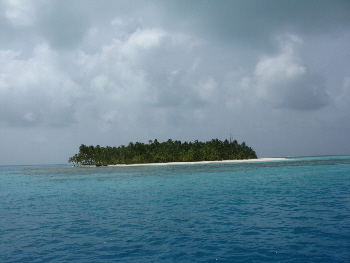
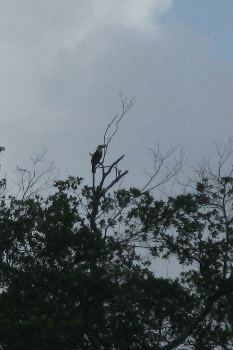
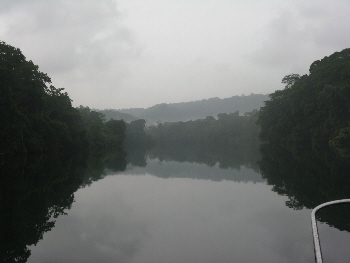
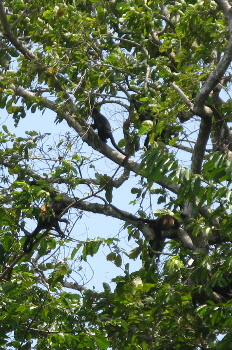
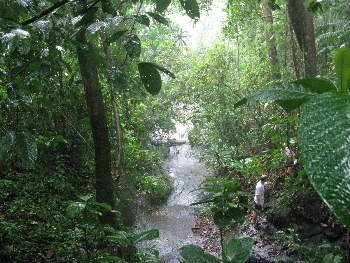
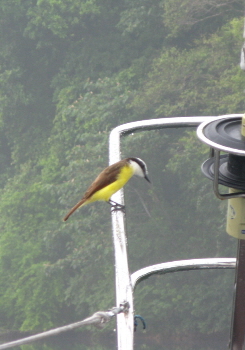
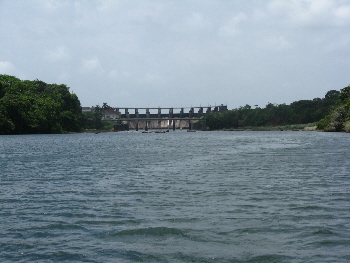
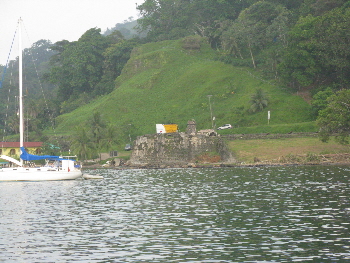
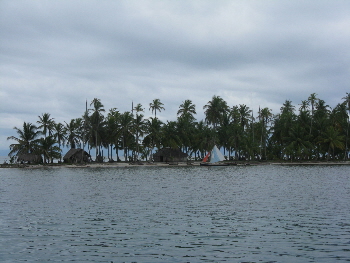
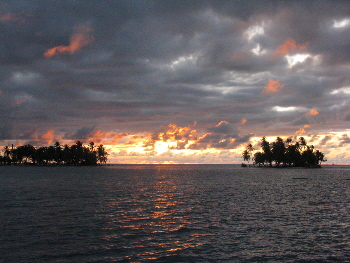
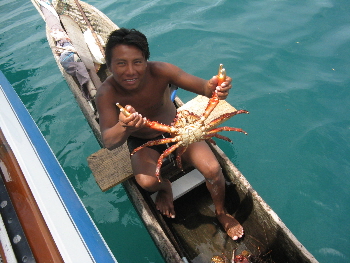
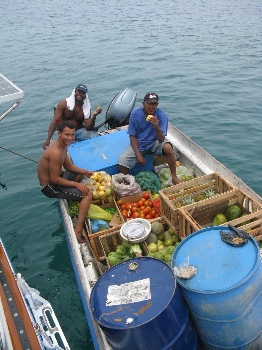
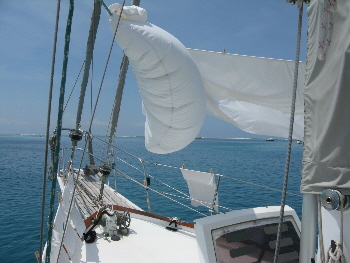
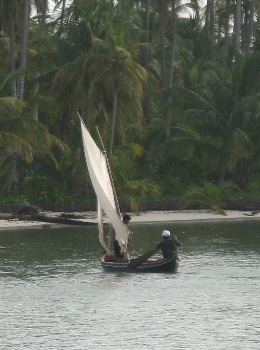
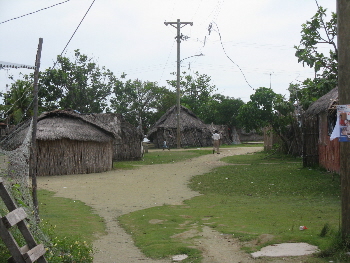
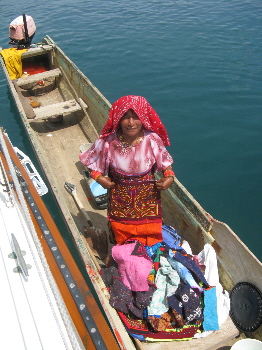
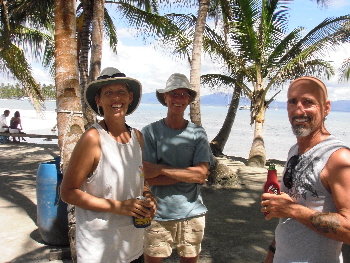
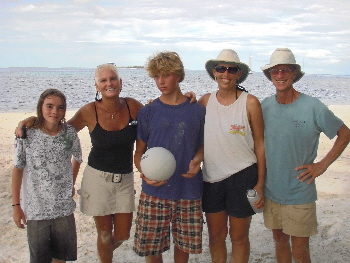
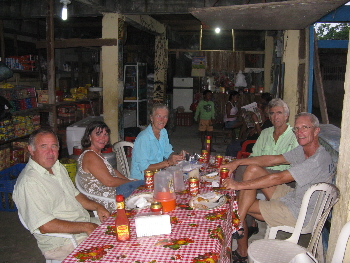
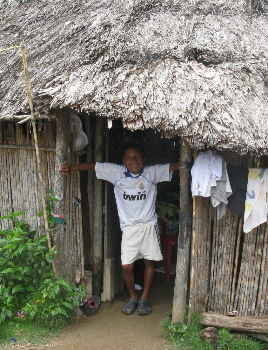
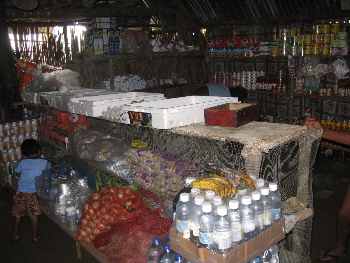
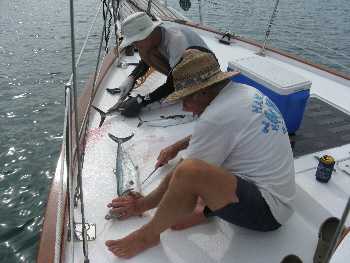
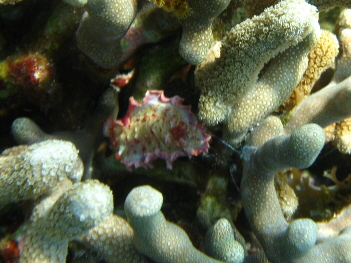
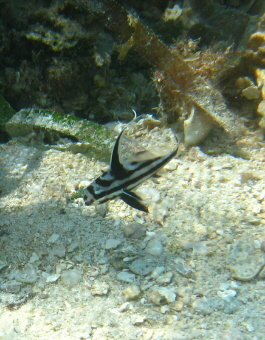
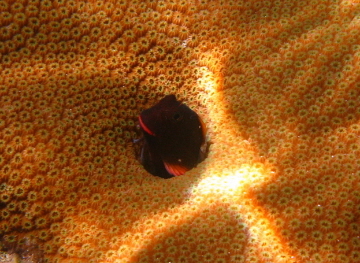
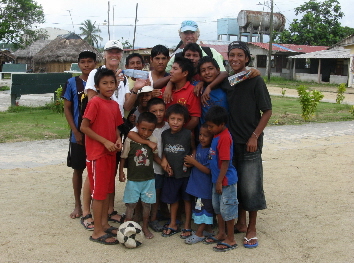
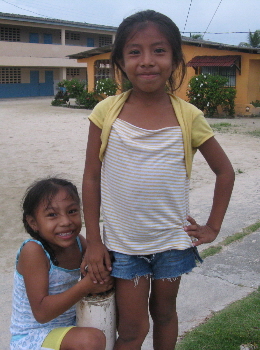
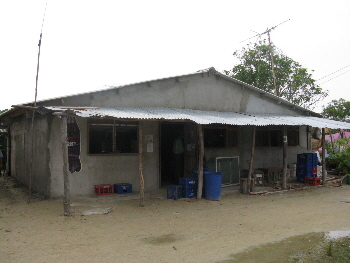
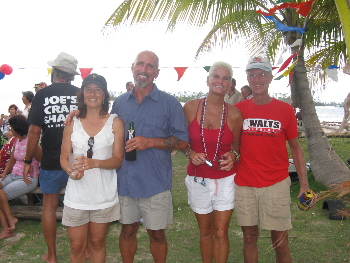
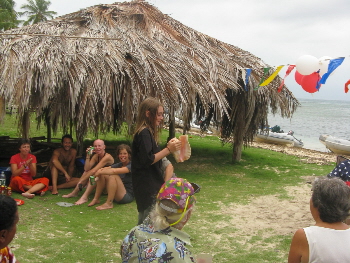
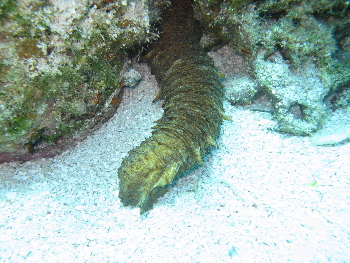
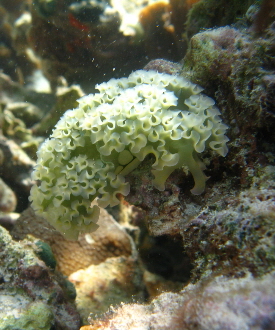
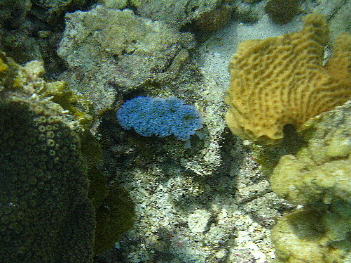
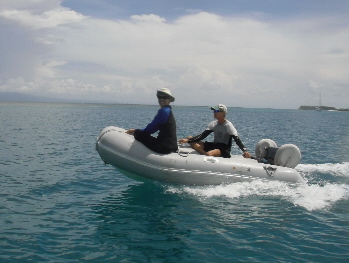
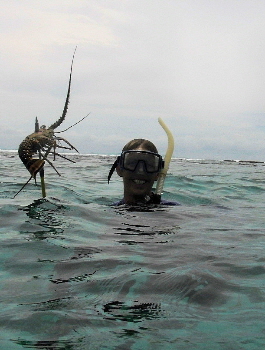
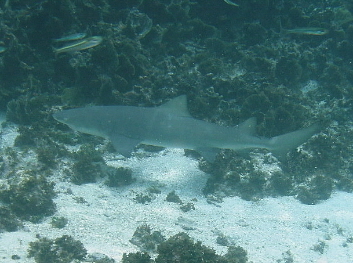
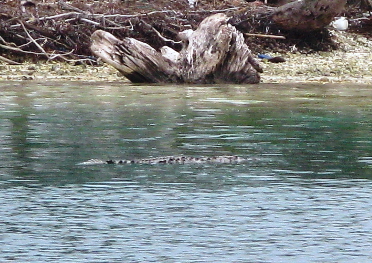
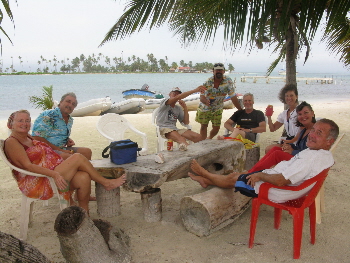
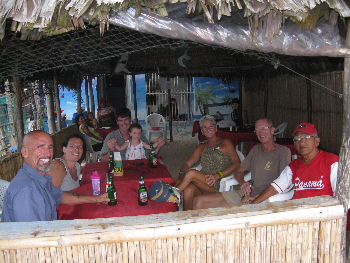
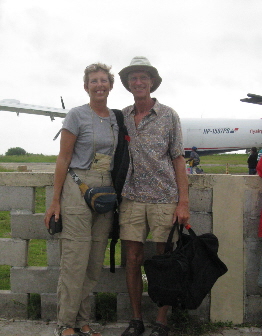
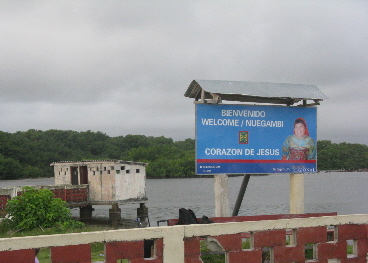
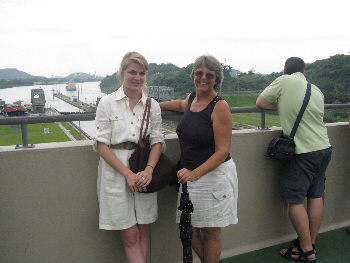
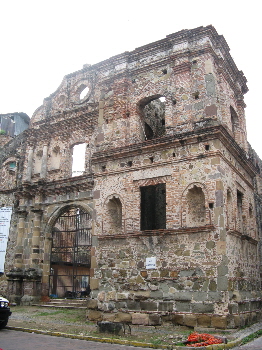
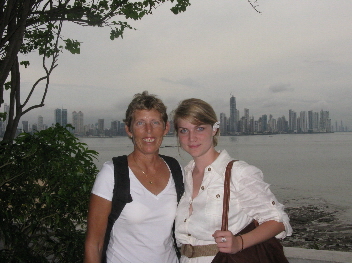
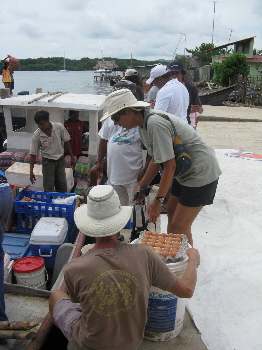
.JPG)
